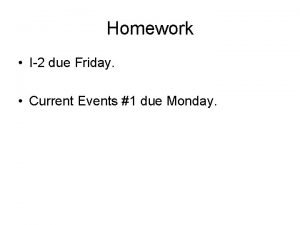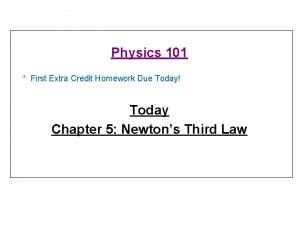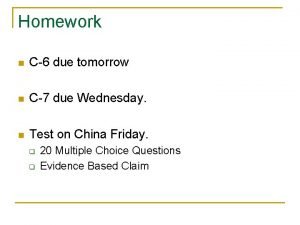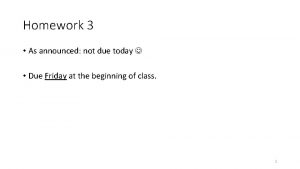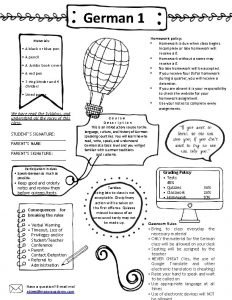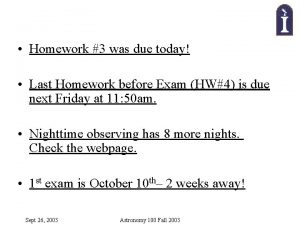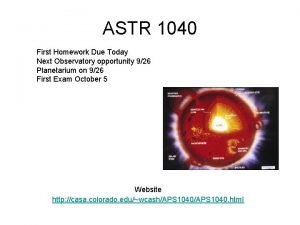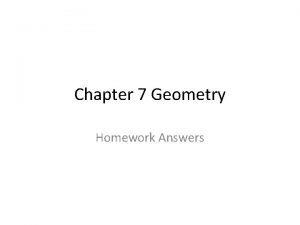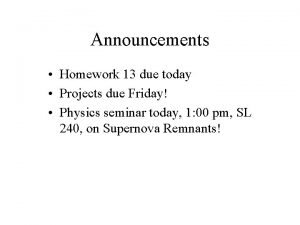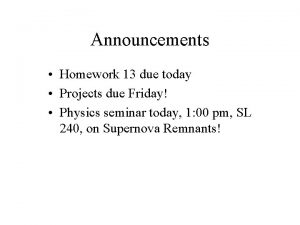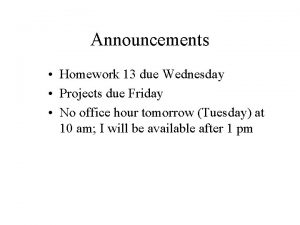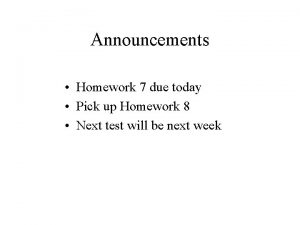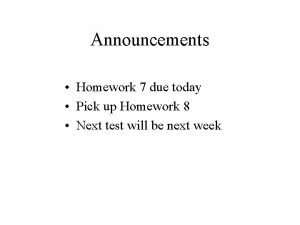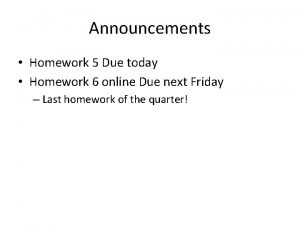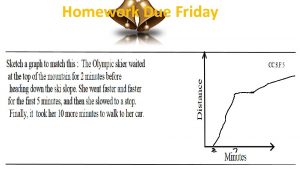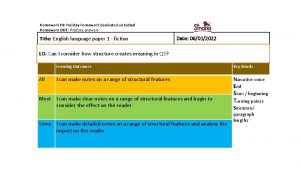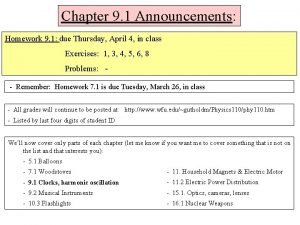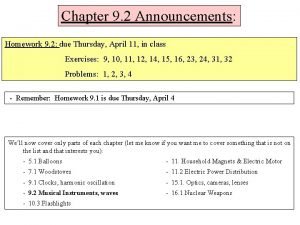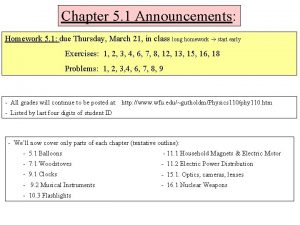Chapter 7 1 Announcements Homework 7 1 due




























- Slides: 28

Chapter 7. 1 Announcements: Homework 7. 1: due Tuesday, March. 26, in class Exercises: 1, 4, 5, 6, 10, 11, 12, 31, 34, 36, 38, 39, 41 Problems: 1, 2, 3, 4 - Remember: Homework 5. 1 is due Thursday, March. 21, in class - All grades will continue to be posted at: http: //www. wfu. edu/~gutholdm/Physics 110/phy 110. htm - Listed by last four digits of student ID Mid-semester grades based on: 10% HW, 15% lab, 5% i-clicker, 70% MT 1 We’ll now cover only parts of each chapter (let me know if you want me to cover something that is not on the list and that interests you): - 5. 1 Balloons - 11. Household Magnets & Electric Motor - 7. 1 Woodstoves - 11. 2 Electric Power Distribution - 9. 1 Clocks - 15. 1. Optics, cameras, lenses - 9. 2 Musical Instruments - 16. 1 Nuclear Weapons - 10. 3 Flashlights

Chapter 7. 1 Woodstoves Transfer of heat; thermal energy Demos and Objects - Candles The sun Heating things up Burning Concepts - Thermal energy = motion of molecules - Temperature scales - Heat - Flow of heat: - Conduction - Convection - Radiation

http: //www. spudspikes. com/ i-clicker-1 When cooking a potato in a conventional oven it is useful to stick a nail in it, which makes it cook faster. This is because A) the nail is a good radiator of heat. B) the nail promotes convection in the potato. C) the nail is a good conductor of heat. D) the nail gets much hotter than anything in the oven.

Some more questions to think about Why is it hotter above a candle than below it? Why does the metal handle of a pot get hot after some time, while a plastic handle usually does not? How does the heat from the sun get to us? Is a black woodstove or a white woodstove more effective in heating a room?

Thermal Energy • is disordered energy • is the kinetic and potential energies of atoms • gives rise to temperature (the hotter an object, the more thermal energy it has) • measured in joules (J) • does not include ordered energies: – kinetic energy of the whole object moving or rotating – potential energy of outside interactions

Temperature Scales Reliable and quantifiable way of measuring how “hot” an object is. How to convert from one temperature scale to another: • Where TC, TF, T is the temperature in Celsius (centigrade), Fahrenheit and Kelvin • Kelvin is the proper SI unit

Fahrenheit (1686 -1736) established three fixed points on his thermometer. 0 degrees: temperature of an ice, water, and salt mixture. 32 degrees: water-ice combination stabilized at "the thirty-second degree. " 96 degrees: “when thermometer is held in the mouth or under the armpit of a living man in good health. " Celsius (1701 -1704) established two fixed points on his thermometer. 0°C: representing the freezing point of water. 100°C: the boiling point of water. Kelvin (1834 -1907) used the same gradation as Celsius but set his zero point at absolute zero (no molecular motion of molecules).

Brief Aside: Thermal expansion of solids and liquids When objects are heated up they typically expand. This is due to the increased motion of molecules at elevated temperatures. Applications: - Thermometers (liquid expands) - Bimetallic strips

Heat • is the energy that flows between objects because of their difference in temperatures • Heat is thermal energy on the move • Technically: object’s don’t contain heat (the contain thermal energy) Units of Heat Since heat is energy transfer it has units of energy: - Joule (SI unit) Also used: -1 calorie (1 cal) amount of energy to raise the temperature of 1 g of water from 14. 4°C to 15°C - 1 Calorie = 1000 calories This unit is most often used in food (a sliver of cheese cake has 500 Calories). 1 cal = 4. 186 J

How is the transferred thermal energy (heat) determined? Heat DQ (change in thermal energy): - temperature of an object is raised by DT - object has mass m - object has specific heat c (material dependent) DQ = m c DT DQ = C DT Which one is hotter: A. Metal B. Water C. equal DQ = change in thermal energy m = mass c = specific heat DT = change in Temp. C = heat capacity

Specific heat: How much energy do you need to heat up 1 kg of that material by one degree K?

Examples and i-clicker-2 & -3: 1. You take one liter of water (1 kg) out of the fridge (0ºC) and want to boil (100ºC) it. How much energy will it take to do that? 2. You do the same with a 1 kg block of copper (0ºC 100ºC). How much energy will it take to do that? 1 A. 0 J 1 B. 100 J 1 C. 4190 J 1 D. 38, 600 J 1 E. 419, 000 J 2 A. 0 J 2 B. 100 J 2 C. 4190 J 2 D. 38, 600 J 2 E. 418, 000 J

Latent Heat and Phase transitions (for lab, also see Chapter 7. 2) Whenever a substance undergoes a phase transition, energy is transferred into or out of the substance WITHOUT causing a change in temperature. Common phase transitions: Liquid to solid: freezing, latent heat of solidification Solid to liquid: melting, latent heat of fusion Liquid to gaseous: boiling, latent heat of vaporization Gaseous to liquid: condensation, latent heat of condensation Solid to gaseous: sublimation, latent heat of sublimation Gaseous to solid: sublimation, latent heat of sublimation

Latent Heat and Phase transitions (for lab, also see Chapter 7. 2) The heat required to change the phase of a given mass m of a pure substance is: L… latent heat i-clicker You put a 10 g ice cube in your mouth. How much energy (in Cal) will your body loose to melt it? (The latent heat of melting for water is 334 k. J/kg). A. ~1 Cal B. ~2 Cal C. ~3 Cal D. ~4 Cal D. ~5 Cal

Latent Heat and Phase transitions (for lab, also see Chapter 7. 2) Energy required to convert 1 g of ice, initially at -30°C to steam at 120 °C.

Heat and Temperature • Touching objects exchange thermal energy – Microscopically, energy flows both ways – On average, energy flows one way • Temperature predicts energy flow direction – Energy flows from hotter to colder – No flow thermal equilibrium same temp • Temperature turns out to be – average thermal kinetic energy per particle

Three forms of heat transfer All three transfer heat from hot to cold 1. Conduction - heat flow through materials 2. Convection - heat flow via moving fluids (air) 3. Radiation - heat flow via light waves

Thermal Conductivity: The heat moves-not the atoms! Examples: 1. __________ 2. __________ 3. __________ Occurs only in connected or touching materials

Thermal Conductivity depends on the material! Best – metals Middle – Insulators Lowest - Gases Also see Table 7. 3. 1 in book

Conduction • Heat flows through material but atoms don’t • In an insulator, – adjacent atoms jiggle one another – microscopic exchanges of energy; atoms do work – on average, heat flows from hot to cold atoms • In a conductor, – mobile electrons help carry heat long distances – heat flows quickly from hot to cold via electrons

Convection: Hot atoms (molecules) move toward cold region carrying thermal energy with them! Examples: 1. __________ 2. __________ 3. __________

Convection • Fluid transports heat stored in its atoms – Fluid warms up near a hot object – Fluid flows away, carrying thermal energy with it – Fluid cools down near a cold object – Overall, heat flows from hot to cold • Natural buoyancy drives convection – Warmed fluid rises away from hot object – Cooled fluid descends away from cold object

i-clicker-4 Why does an ice cube feel cold? A) Heat from your hand enters the cube by convection. B) Cold from the cube enters your hand by convection. C) Heat from your hand enters the cube by conduction. D) Cold from the cube enters your hand by conduction.

Radiation Examples: 1. __________ 2. __________ 3. __________ • Heat transferred by electromagnetic waves (radio waves, microwaves, light, …) • Does not need a medium to travel!

Radiation • Heat transferred by electromagnetic waves (radio waves, microwaves, light, …) • Wave types depend on temperature – cold: radio wave, microwaves, infrared light – hot: infrared, visible, and ultraviolet light • Higher temperature more radiated heat • Black emits and absorbs light best

i-clicker-5 The surface of the moon is exposed to full solar radiation because it has no atmosphere. Why then does the moon not heat up endlessly until it disintegrates? A) Convection in the soil carries energy away. B) Its temperature rises until it is able to radiate heat away into space as fast as it arrives from the sun. C) It has disintegrated but the light just hasn’t reached us yet. D) Because it is isolated from the sun by empty space, the sun's heat can't reach it (only light can) and they don't experience any changes in temperature.

Stefan-Boltzmann Law • The amount of heat a surface radiates is P = e x s x T 4 x A P - radiated power (energy per time) e - emissivity (ranges from 0 (bad) to 1 (good) 0 is white, shiny or clear; 1 is black s - Stefan-Boltzman constant = 5. 67· 10 -8 J/(s·m 2·K 4) T - temperature in Kelvin A - surface area

Radiation: You can tell the temperature of a hot object from its color (infrared) Some cameras ‘can see’ infrared; see false color image at left
 Pvu announcement
Pvu announcement R/announcements!
R/announcements! Church announcements
Church announcements What happened when montag crossed the ten-lane highway
What happened when montag crossed the ten-lane highway Kayl announcements
Kayl announcements General announcements
General announcements Jack prelutsky homework oh homework
Jack prelutsky homework oh homework Homework oh homework i hate you you stink
Homework oh homework i hate you you stink Jack prelutsky homework oh homework
Jack prelutsky homework oh homework Homework oh homework i hate you you stink
Homework oh homework i hate you you stink Alitteration definition
Alitteration definition Example of literal language
Example of literal language Homework due today
Homework due today Homework is due on friday
Homework is due on friday Homework is due on friday
Homework is due on friday Black cat analogy
Black cat analogy Homework due today
Homework due today Ilegalism
Ilegalism Homework
Homework Homework is due
Homework is due Iron core
Iron core Homework due today
Homework due today Homework due today
Homework due today Quadrilateri con due lati paralleli
Quadrilateri con due lati paralleli Liberty chapter 20
Liberty chapter 20 Due're/due opposti
Due're/due opposti Due piccole sfere identiche sono sospese a due punti p e o
Due piccole sfere identiche sono sospese a due punti p e o Geometry homework answers
Geometry homework answers Chapter 4 homework accounting
Chapter 4 homework accounting













